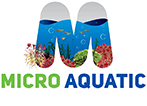Artists commonly use these principles when constructing their artworks. If you can manage to incorporate them in your aquascape you'll end up with a gorgeous result too.
The Rule of Thirds is often used particularly when composing a photo. It involves dividing an image into three parts in both directions and then placing focal points or objects of interest at one or more intersection points of the dividing lines.
If you set your tank up by dividing it up into similar sections and placing your plants and decorations to highlight the intersections, you'll do well.
Similarly, the Golden Ration is a mathematical formula which is used to locate the ideal spot for a focal point - perhaps a rock or driftwood trunk - in your tank.
Water filters: - Water Filters are one of the most important pieces of equipment for your aquarium. They remove all the bad stuff from the water - fish excrement, extra food, chemicals etc.
Aquarium Light: - Lighting is also very important - it affects the growth and health of your aquatic plants.
Aquarium Substrate: - The material covering the bottom of your tank, known as substrate. This can be a variety of things but it's important to get it right as your plants feed through their roots.
Aquarium Liquid Fertilizers: - They also feed through their leaves, so using a proper dosage of liquid fertilizers will help your plants to grow the right size and colour.
To add to the mix in the water, CO² is essential. All plants need CO² to grow, so make sure you have an appropriate CO² system for your tank.
Aquarium Decorations: - Finally, there are the aquarium decorations that are available, particularly these days ornaments such as driftwood and rocks. These help to provide much-needed form and focal points around which your plants can be arranged. They are the skeleton beneath the body of plants and your skill in arranging them will delight for years to come.
So where do you start putting your fish tank aquascape masterpiece together? What's your inspiration? Like many forms of art, aquascaping is also represented by a number of styles and approaches. You'll just need to find what suits your personal taste and follow along!
If rocks are your thing, then check out the Iwagumi Style, which is all about the careful arrangement of various types of rocks, whilst keeping the plants low and unimposing.
At the complete opposite end of style is the Dutch Aquarium, which focuses on plants, plants and more plants, with barely a rock in sight. In all kinds of leaf shapes, sizes and colours, the manicured plants are arranged for a pleasing effect.
Again very much focused on plants is the Nature Aquarium, a style introduced by Takashi Amano from Japan in the 1990s. This style is very natural and aims to recreate, with the assistance of driftwood and rocks, a landscape from the above-water world, whether that's a forest, valley or mountain.
Finally, the Jungle Style takes the stage. This one is popular as it's one of the simplest to create - no manicuring here, it's wild and untamed in appearance. So if you don't have the time for maintenance, this might be your salvation.
Do you already have an idea of the aquarium fish you want? Think carefully about what to put in your tank, so you don't go disturbing your carefully created work. Often the fish used in these environments are on the smaller side and tend to school, with bright colouring to enhance your aquarium.









Leave a comment
Please note, comments need to be approved before they are published.